WORLD CLASS COACHING
Club Curriculum U13/14 Season
By Tony Englund
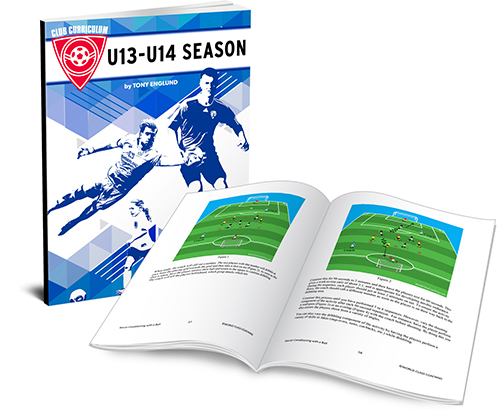
TABLE OF CONTENTS
Part Three
TECHNICAL SESSIONS
Training Session #14: Playing in the air
Introduction: As the size of the field and the abilities of the players to drive balls over distance increase, the capability and willingness of players to deal with a ball played at them in the air become very important. This session provides a mix of fun, challenging environments in which players’ comfort playing in the air will increase.
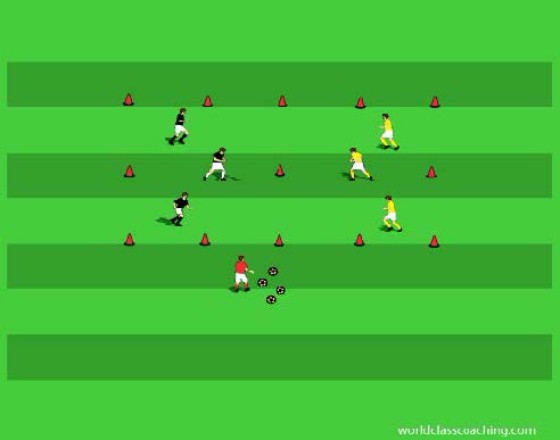
Soccer Volleyball - back to back 6x8 yard grids
Play 3v3 soccer volleyball games. This is a fun and flexible activity to warm-up in a session focused on playing in the air. To begin, the coach serves balls randomly to either grid. Each team is allowed one bounce of the ball on their side of the cones each time the ball enters their area (for advanced players, no bounces should be allowed). Play to ten points.
Variations:
• play multiple games simultaneously and have the grids compete against each other for the highest single total number of exchanges (one point for each ball played from one side of the center line to the other.
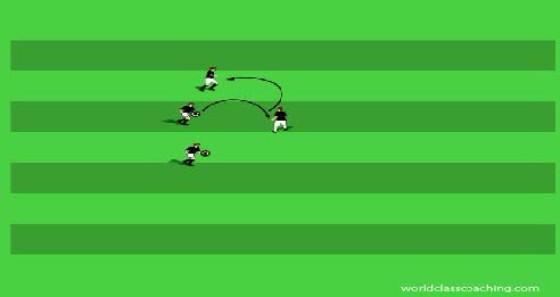
Three serving one with two balls10x10 yard areas
Three servers (two with balls) passing balls in turn to the working player, who plays first time each successive service to the player without a ball (rotates with each serve). This environment compels the receiving player to redirect the ball in the flow of the exercise and with technical speed.
Progression:
• serves are tossed underhand for the working player to volley first-time to the open player
• serves are tossed underhand for the working player to play 2-touch in the air (serves should be chest or thigh height)
• serves are tossed underhand for the working player to head first-time to the open player
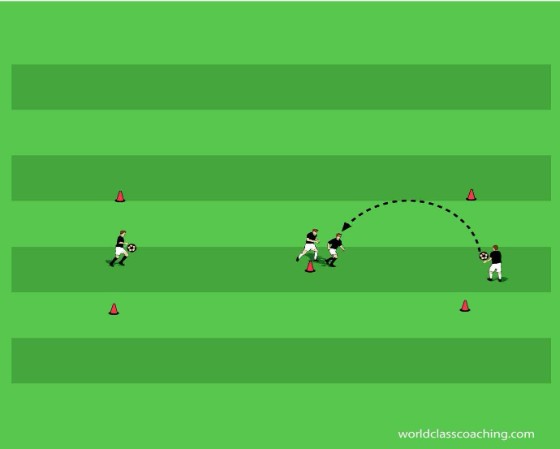
Competitive Heading - 10x10 yard areas
Players work in groups of 4, with two working players in the middle and two servers on the ends with soccer balls. The working players return to the center cone after each duel. Servers toss balls for the working players to try to head back to the servers. Any ball caught by the server is a point for the working player who headed the ball. Encourage servers to vary the height and type of service (i.e. lofted ball or flat throw).
Variations:
• players need to settle the ball before playing back.
• players need to flick the ball on to the other server (shorten the area of play for this variation).
Flankenspiel - 40x25 yard area
Each team provides a crosser at a corner on their attacking end. Restarts are by cross and from alternating ends. Give two points for a first-time finish on a serve out of the air and one point for any other goal.
Training Session #15: Heading.
Introduction: This session reviews technical heading, working players through a progression designed to strengthen the power and refine the technique of their striking, and then gives players the opportunity to utilize heading in a game situation.
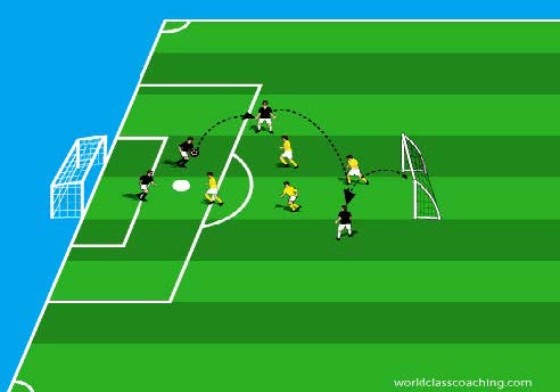
Team Handball - 25x25 yard area with full-sized goals
Divide the group into two teams. Players pass the ball with their hands but can only score off of a serve from a teammate resulting in a header. Defenders can use their hands to block or intercept passes. Any ball that hits the ground is a turnover and play restarts from that point. Players in possession are limited to three seconds and three steps.
Progression:
• every other pass must be a header, and goals can only be scored off of a serve from a teammate that results in a header at goal.
Pairs technical heading progression - touch line area
Players work in pairs with one soccer ball through each stage of the progression. At each level, emphasize safety (eyes open, mouth closed) and quality repetition. Explain that the progression is designed to isolate particular muscle groups and motions that strengthen heading and improve technique.
Progression:
• active player laying on her front side. The active player lays down facing her partner with her arms fully extended and supporting her shoulders and head. The server prepares to toss balls underhand and not more than a foot in front of the working player’s head. The working player initiates each repetition by arching her back and pulling her head and shoulders back away from the server.
1. eyes open, mouth closed.
2. contact point is the hair line at the top of the forehead.
3. shoulders and head should be locked with the head forward and the shoulders pushing away at the moment of contact.
4. drive the ball back into the hands of the server.
• active player seated. The active player initiates the repetition by leaning back to do about 1/3 sit-up.
1. utilize the lower back muscles, in addition to the points of emphasis above.
2. Now the arms are held low and forward before contact and then thrust away from the ball (accentuating the shoulder movement) at the moment the ball is struck.
3. drive the ball back into the hands of the server.
• active player standing. The server initiates each repetition with the toss.
1. in addition to the above points of emphasis, it is advisable for young players in particular to have them stagger their feet, with one foot closer to the server and one comfortably further away. The working player starts each repetition with her weight on her away foot and transfers the weight to the front foot as part of the striking motion. This posture adds power and also gives a longer time window for timing the heading motion.
2. attacking heading. In attacking situations (i.e. in finishing crosses), it is often best to drive the ball downward (this makes it very difficult for defenders and the goalkeeper to react to). Show players that to create a downward angle on the header, the players need to contact the ball on the back side and above the center-back.
3. defensive heading. In defending situations (i.e. defending crosses) it is preferable to head the ball upward, clearing the ball away from danger and giving the defense time to organize while the ball travels. Show players that to create an upward angle, they need to contact the ball on the back side and below center.
Pairs heading contest - touch line area
Working in pairs with one ball, see which group can complete the most consecutive headers. Players must alternate touches. Restarts are by a toss from one partner to the other. Explain that this exercise simulates defensive heading, as it requires that the ball be headed upward t one’s partner. Players can use their feet, thighs and shoulders (not hands) to sustain their juggle, but those touches do not count toward the total. Keep track of the single best sequence for each pair.
Variation:
• Rather than tracking the best single sequence, record the total number of headers by each pair throughout the exercise. This is a useful variation for very young players in that it encourages repetition rewards hard work if the players are unsuccessful with the standard rules of the game.
• 2-touch heading. Same contest except that each player must head the ball twice each time they receive the ball in the sequence. This restriction develops touch in heading and helps differentiate between a controlling (1st touch in sequence) and a driven touch (second touch played to partner). Each touch counts as a point.
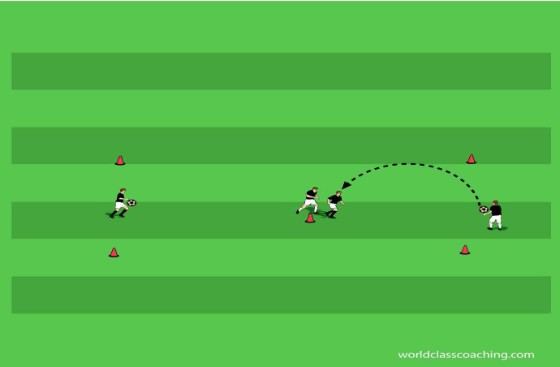
Competitive Heading - 10x10 yard areas
Players work in groups of 4, with two working players in the middle and two servers on the ends with soccer balls. The working players return to the center cone after each duel. Servers toss balls for the working players to try to head back to the servers. Any ball caught by the server is a point for the working player who headed the ball. Encourage servers to vary the height and type of service (i.e. lofted ball or flat throw).
Variations:
• players need to settle the ball before playing back.
• players need to flick the ball on to the other server (shorten the area of play for this variation).
4v4 Games to goal with controlled restarts - 18-yard box
Play 4v4 games to goal with all restarts coming from throw-ins. This restriction creates numerous opportunities for players to duel in the air.
Additional ideas:
• goalkeeper re-starts are short, high punts.
• goals can only be scored off of crosses (add neutral crossers to promote).
Training Session #16: Long Passing.
Introduction: This session features a progression from basic passing through technical long passing and then a pair of playing environments where playing over distance is required. At this stage in their development, players should be working very hard to become proficient playing over distance with either foot.
Passing warm-up - ½ field
This exercise requires soccer balls of several different colors (three is preferable). There should be ½ as many balls as the total number of players. Players are instructed to spread out around the playing area. The team jog around the area, exchanging the soccer balls in the prescribed manner. For example, a white ball calls for a throw-in; a red ball indicates a short pass, and a black ball must be played over distance (long pass – which should be at least 15 yards). Play for three minutes. The coach can use this time to assess the players’ ability to play a variety of passes with particular emphasis upon long passing.
Pairs passing - Touchline
Players work in pairs with a soccer ball for each pair to start (have a second ball nearby).
Progression:
• two-touch passing. Players pass in pairs using two touches. Emphasize technical speed and proper technique, including locked ankle, utilizing the inside of the foot, pointing the plant foot toes at the target and holding the foot momentarily after the strike to accentuate proper follow-through. Players should alternate the strike foot with each pass. Play for one minute and then change partners.
• one-touch passing. Players pass in pairs using one-touch where possible. Here the emphasis is upon measuring the strike so that the ball can be returned with one-touch. Once again, players must lock ankles, point the plant foot at the target, and use the laces surface. Players should also change the passing foot with each strike. Finally, point out to players that they need to be aware of the part of the ball that they strike. To keep the ball on the ground, players should focus on striking just above the mid-point on the back of the ball. Play for one minute and then change partners.
• two-ball passing. Players pass in pairs with two balls using two touches. Here, the players must work to develop a rhythm in both passing and receiving. Players pass the ball simultaneously with their right foot and receive the pass from their partner with their left foot. Their first touch should be made with the inside of their left foot and should push the ball forward and across their bodies so that they may pass the ball with the inside of their right foot as the sequence begins again. The purpose here is to apply light technical pressure while also developing consistency in technique. Play for one minute and then change the passing and receiving foot.
• pairs laces passing. Players work in pairs with one soccer ball. Here the players stand about four yards apart and focus on passing the ball to their partner with their laces surface. As the focus of the session is long passing, the laces surface will be critical to the technical success of the session, so players must focus on getting their toes down, locking their ankles and finding a comfortable placement for their standing foot, pointing the toes toward the target of the pass. Players work to get consistency in their strikes. After each pass, the ball should be stopped so that the technique can be practiced in isolation. Players should alternate the passing foot with each strike.
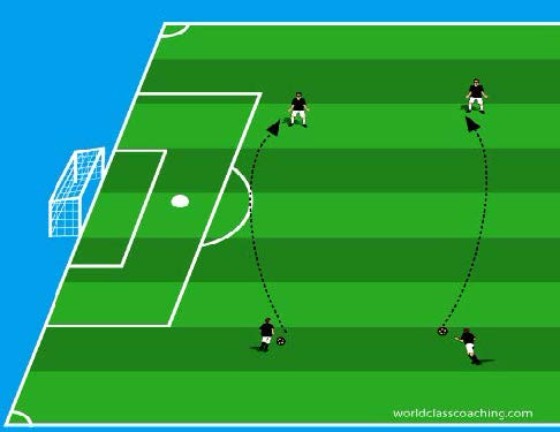
Driving range - ½ field
Introduce long passing. There are three types of long pass: Driven, lofted and chipped. Demonstrate one pass and allow players to practice striking the ball with a partner over a twenty to twenty-five yard space for about four minutes, compelling players to switch to their off foot after two minutes.
• driven pass. This pass is very similar to a driven shot. This pass is used to send the ball over distance as fast as possible. The pass is driven and usually not more than shoulder high, and is often used to cross the ball (near post usually) or to change fields, and to play sharp, long through balls.
1. lock the foot with the toes pointed down.
2. use the laces to strike the ball.
3. the plant foot is placed comfortably next to the ball and in a more forward position than in the lofted or chipped balls. This placement helps to limit the height of the pass.
4. players should think of their leg below their hip being locked and the hip as the point of rotation, as this will increase consistency and power.
5. the strike point on the ball is on the center back, slightly above center. Again, this will aid in keeping the ball down.
6. follow-through should be held to emphasize a clean strike and balance and also the foot should be kept low.
•lofted ball. This pass is used to put the ball over defenders to teammates. Typically, the lofted passis utilized when the ball is crossed to the back post, or cleared from the back line, and also in changing fields and sometimes in playing through-balls.
1. lock the foot with the toes pointed down.
2. use the laces to strike the ball.
3. the plant foot is placed comfortably next to the ball and in a more withdrawn position than in the driven ball. This placement helps to create the height of the pass.
4. players should think of their leg below their hip being locked and the hip as the point of rotation, as this will increase consistency and power.
5. the strike point on the ball is on the center back, below center. Players need to learn to feel their laces cupping beneath and on the back of the ball. This lower striking position helps to raise the ball off of the ground for a lofted pass. Follow-through should be held to emphasize a clean strike and balance and also the foot should be raised to accentuate the lift placed on the ball.
• chipped ball. This pass is used to drop a ball over a defender or group of defenders to the feet of a target. This is the most difficult of the passes to learn well, but it is also important for players to learn to perform this skill in that it teaches a new way to strike the ball in a way that is important for consideration in numerous situations on the field. Chipping the ball is particularly useful in that the strike creates backspin, allowing the ball to settle off of the bounce, meaning that the receiving player should be able to play it more easily and quickly than a driven or lofted service. The ball is often chipped on free kicks to put it behind the defense; on through-balls; to change fields to a particular target; sometimes to find a target on a short cross, etc.
1. lock the foot with the toes pointed down.
2. use the laces to strike the ball.
3. the plant foot is placed comfortably next to the ball and in a more withdrawn position than in the set for the driven ball. This placement helps to create the height of the pass.
4. players should think of their leg below their hip being locked and the hip as the point of rotation, as this will increase consistency and power.
5. the strike point on the ball is on the center back, well below center. Players need to learn to feel their laces cupping beneath and on the back of the ball. This lower striking position helps to raise the ball off of the ground for a chipped pass.
6. the follow-through is the major difference between the chipped and lofted passes. With a chipped ball, there is no follow-through. In -the strike, the player “digs” beneath the ball and then does not follow-through. Players must practice both of these cues, as part of the learning here is that with the chip, there is a bit of contact with the ground, which helps create backspin on the pass, and the lack of follow-through will not feel natural at first, but this also increases the backspin effect on the pass.
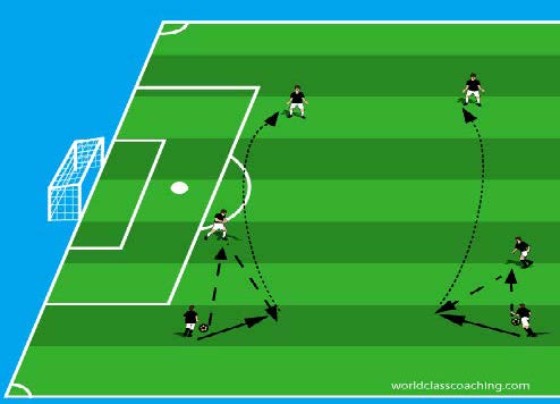
Short-short-long - ½ field
Players work in groups of three with one soccer ball. Demonstrate with one group. Put two players about twenty five yards apart and the third player between them. Give one of the end players the ball. The inside player starts the
exercise by checking (running) toward the player with the ball. The ball is passed to the inside player who returns it with a single touch if possible. The end line player then takes a touch to settle the ball before playing a long pass to the end line player on the other side. The inside player then checks to the player with the ball and the sequence continues. This is a commonly used exercise that can be adjusted to train long passing at any level.
Here are some additional considerations for the coach in tweaking the exercise:
• players learning to chip and loft the ball often benefit from having a target to play over. Therefore, with a warning about playing safely, the end line players can be encouraged to play lofted or chipped balls over the central player to their target on the other side.
• to make play more realistic, players who can already long pass well can be required to play the long pass one-touch (no settling touch) off of the return pass from the central player.
• notice in the diagram that the angle of the return pass from the central player is changed. This is done both to create a better approach angle for the outside player and to force a defender pressing the central player to adjust her run if she were to try to press the long-passing player. The long-passing player should indicate (using a hand signal) to the central player where she wants the ball played to set up the long pass. These considerations are not as important for players just learning the technical aspects of long passing, but are very important details for more advanced players.
• another variation that adds some emphasis on skill for more advanced players is to encourage the end line players to receive and play the pass to the central player with one touch. This will force them to play the ball in the air sometimes and to learn to take some pace off of the ball in making the pass.
• finally, to add a bit of skill emphasis for the central players, have the end line players receive and control the ball off of the long pass and then pick the ball up and take a throw-in toward the central player who settles the ball before playing the set-up pass back to the end line player.
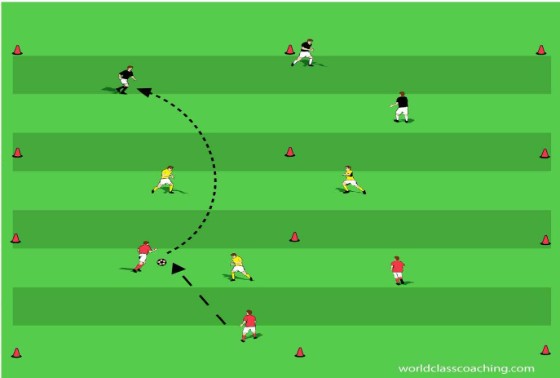
3-zone passing game - 20x42 yard grid
Split the group into three teams and put them into different-colored vests. Each team occupies one of the three zones. Explain that the purpose of the game is to practice long-passing between the two end grids. For teams just
learning to long-pass, the players are all confined to their respective zones. The coach serves a ball to either end grid. The team in that grid knocks the ball around to find a useful angle to play through to the far grid. The player in possession then lofts, drives, or chips (the coach can require a particular type of pass) the ball to the far grid. The team in the central grid attempt to knock down (no hands) the pass.
For players learning to long pass, keep the central team in their grid even if they win a ball. Instead, the coach plays a ball into the other end grid and the players there attempt to play through or over the central grid to the far grid. Play for two minutes, giving each end team a point for every successful long pass. The central team also earns a point for each pass they knock down.
Here are more advanced variations:
• every time the middle team knocks down a ball, their team takes the place of the team failing to play a successful pass and that team moves to the middle grid.
• teams must receive the ball properly after a long pass or move to the central grid.
• the central team sends one player into the end grid when the ball arrives there. If that player wins the ball or forces the ball out of the grid, her team exchanges places with the team losing the ball.
• building upon the last variation, require the endline team to string together 4-5 passes before playing a long pass. This allows the pressuring player from the center grid to apply pressure before a long ball can be played and also compels the teams in the end grids to be more active, making the game more realistic. When introducing this restriction, it is often useful to freeze the pressuring player from the center grid once the team in possession has strung together 4-5 passes. This will usually give enough success to develop some flow in the exercise. Then remove the “freeze” restriction so that the end grid teams are forced to play long passes under some pressure.
5v5 with a dead zone - full field (divided into 3 zones)
Play 5 vs. 5 with a neutral dead zone. Each team places three players plus a goalkeeper in their defensive zone and two players in their attacking zone. No player may enter the dead zone. The coach has a supply of balls on the side of the dead zone and he or she restarts play from there any time a ball leaves play. The defenders have a 4 vs. 2 advantage in their respective zones and their purpose is to win the ball and play a long pass over or through the dead zone to a teammate in the attacking zone. Play this way for ten minutes and then remove the dead zone, allowing open play, but encouraging players to look for a long pass to set up scoring opportunities and to clear their own defensive zone.
Training Session#17: Volley and half-volley.
Introduction: The ability to volley and half-volley become very important as more of the game is played in the air and both finishing (often off of crosses) and urgent clearances requiring both skills become regular features. This session challenges players to improve their technical ability to strike a ball in the air or just after a bounce.
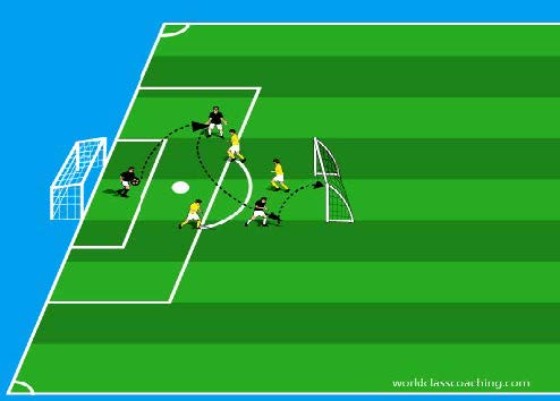
Gaelic football - 30x35 yard area
Divide the group into two equal teams. Play on the prescribed field size to two full-sized goals (the game can be played with or without goalkeepers). This game is similar to team handball except that instead of throwing the ball around in possession, teammates must volley (or half-volley) the ball to one-another (serve the ball to one-self), and goals are scored by volleying the ball into the goal. It is important to emphasize, for safety reasons, that defenders cannot take the ball away from a player in possession and cannot attempt to block a volley or half-volley. Passes can be intercepted and any ball hitting the ground is an immediate turnover. The player in possession is allowed three seconds and three steps with the ball, with any violation resulting in an immediate turnover at the spot.
Variations:
• all exchanges and attempts at goal must be made off of the half-volley.
• attempts at goal must be off of a serve from a teammate.
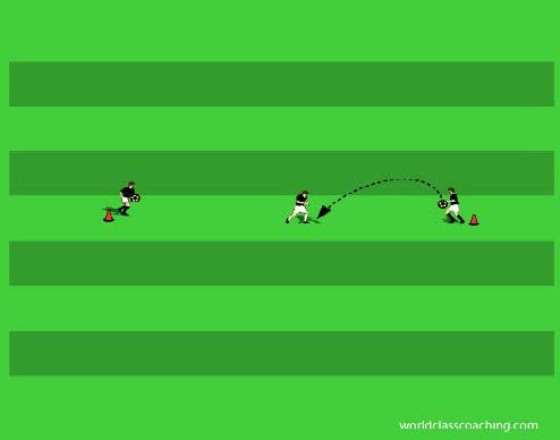
3’s technical volleying and half-volleying - 10x12 yard areas
Players work in groups of three with two soccer balls as shown. The central player shows first to one server and then the other. Work through the following progression:
• 1-touch passing. The players serve and return the ball first-time, with the servers alternating the foot to which they play.
• volley. Servers toss balls at knee height and lower, for the working player to volley back first-time.
Coach:
• lock the ankle at striking point.
• the knee is bent and also locked.
• the hip is the rotating point to reach and follow through the striking position.
• use the laces surface to strike the ball.
• target point on the server is the waist.
• alternate foot to which ball is served.
• rotate the working player after one minute.
Progression:
• half-volley. The servers expand the space by several steps to give the working player more room to adjust to each serve.
Coach:
• the technique for half-volleying is similar to that for volleying except for the timing. Here, the player attempts to contact the ball just after it bounces. The serves must therefore be made to bounce in front of the working player. Encourage the players to take short steps in preparation so that they can adjust to the ball. The timing may take some time to master, but once acquired, this skill can produce very powerful strikes.
Variation:
• competition: Which group of three can catch the highest number of volleys/half-volleys? Add up the score for all three rounds.
Volley and half-volley to goal - 18-yard box
Players line up along the top of the 18-yard box and a goalkeeper is in goal. Each player has a ball. Players hold their soccer balls. One after another, they serve to themselves, attempting to volley the ball on goal. After several opportunities for each player, compel players to strike the ball with their off foot.
Coach:
• short steps, good timing.
• consistent tosses. Some players will try to toss the ball very high, making their timing very difficult to set. Tosses should be about head height.
• advanced striking. Once players are able to time and strike the ball with consistency, it is important that they learn early on that their most powerful and effective volleys will be struck by putting the ball outside of their body frame on the striking side. The reason for this is the fact that if the ball is underneath them, their natural power stroke will finish with the foot rising, a leading contributor to the large percentage of volleys that fly high over the goal. If the ball is struck outside of the frame, with the player rotating on their away hip and leaning in that direction, it is possible to create a level, long power striking area, and players should learn to strike balls both underneath them and also outside of their frame.
Progression:
• the coach is located at the penalty spot and tosses balls for players to run on and volley.
• half-volley. Players serve their own balls and attempt to half-volley the ball at goal. Once again, players should become accustomed to striking balls with both feet and also finishing balls struck directly in front of them and also off to either side.
• the coach is located at the penalty spot and tosses balls for players to run on and half-volley.
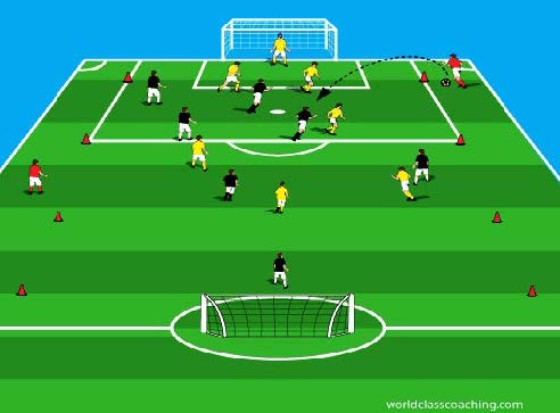
6 vs. 6 plus goalkeepers and neutral crossers - ½ field
In this game, all goals must be scored off of crosses and the goal must also come from a volley or half-volley. The neutral crossers must remain in the crossing zones and play at speed, but no other players can enter the crossing zones. Instruct the crossers to play low, driven crosses to try to set up opportunities to finish with a volley or half-volley.


